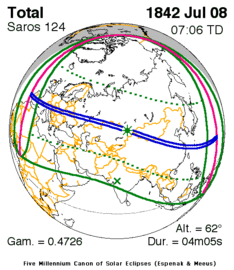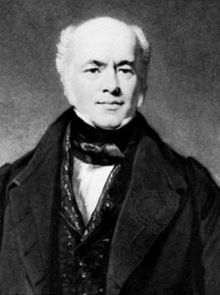Solar eclipse of July 8, 1842
| Solar eclipse of July 8, 1842 | |
|---|---|

|
|
| classification | |
| Type | Total |
| area |
North Africa , Europe , Arctic , Asia Total: Portugal , Spain , France , Italy , Austrian Empire , Russian Empire , Chinese Empire |
| Saros cycle | 124 (45 of 73) |
| Gamma value | 0.4726 |
| Greatest eclipse | |
| Duration | 4 minutes 5 seconds |
| place | Russia |
| location | 50 ° 6 ′ N , 83 ° 36 ′ E |
| time | July 8, 1842 7:06:21 UT |
| size | 1.027 |
The total solar eclipse of July 8, 1842 was visible in North Africa , Europe , the Arctic and almost all of Asia . The path of totality stretched from Portugal via Spain , southern France , northern Italy , then from the Austrian Empire via the Russian Empire to the Chinese Empire . The longest duration of the solar eclipse of 4 minutes and 5 seconds was reached near the Kazakh city of Öskemen .
The solar eclipse of July 8, 1842 belongs to the Saros cycle 124.
Observations
In Perpignan in southern France, where the totality was 2m 17s in the early morning, the French physicist François Arago reports : On July 8, 1842, around 2,000 people of all classes, scholars, burghers, country folk and soldiers flocked to Perpignan for the great one to observe total solar eclipse in the south of France. Thanks to previous clarification of the nature of the process, there were probably only a few among these people who were not fully convinced that this phenomenon belonged to the natural, regular, calculable phenomena for which one had no cause in common understanding to worry about. At the beginning of the darkness only curiosity and competition seemed to move the crowd, who had broken out into a monstrous scream at the sight of the first small section on the western edge of the sun. But when the sun, cut back to a narrow strip, began to cast a weak, uncertain light over the landscape, a visible restlessness took hold of the spectators; everyone felt the need to convey his feelings to those standing by, and a muffled roar like the roar of a distant sea rose from the crowd. This dull roar swelled more and more, the narrower the sun crescent became. At last it disappeared, darkness set in, and a dead-like silence marked this phase of darkness as sharply as a pendulum on the astronomical clock would have done. The disappearance of the daytime star, from which the source of all earthly life, warmth, flows, had overcome the willfulness of youth, the carelessness of gossipers, and the noisy indifference of the uneducated. There was deep silence in the air too, and the birds had stopped singing .
In German-speaking countries, the description of Adalbert Stifter , who experienced the darkness in the morning of Vienna with a duration of 2m 1s, is widespread. Its description is given in the article on solar eclipses . Since the next total solar eclipse of August 19, 1887 was not visible due to bad weather, the description aroused great expectations for the solar eclipse of August 11, 1999 , which, however, were also disappointed in many places because of the bad weather.
Francis Baily observed the solar eclipse in Italy. His focus was on observing the solar corona and prominences . He discovered that these phenomena are part of the solar atmosphere. The Baily's pearls ( better known in German as the "Perlschnurphänomen") are named after him in order to honor him for his correct explanation of the phenomenon in 1836.
Individual evidence
- ↑ Dr. R. Buschick: Sternkunde und Erdgeschichte , 1927 p. 155.

